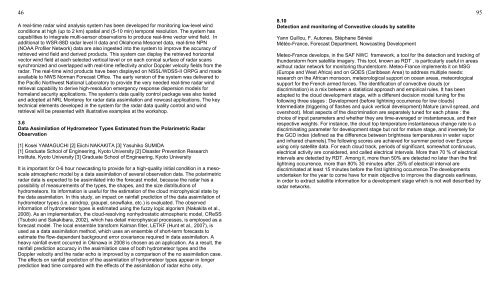World Meteorological Organization Symposium on Nowcasting - WMO
World Meteorological Organization Symposium on Nowcasting - WMO
World Meteorological Organization Symposium on Nowcasting - WMO
You also want an ePaper? Increase the reach of your titles
YUMPU automatically turns print PDFs into web optimized ePapers that Google loves.
46<br />
A real-time radar wind analysis system has been developed for m<strong>on</strong>itoring low-level wind<br />
c<strong>on</strong>diti<strong>on</strong>s at high (up to 2 km) spatial and (5-10 min) temporal resoluti<strong>on</strong>. The system has<br />
capabilities to integrate multi-sensor observati<strong>on</strong>s to produce real-time vector wind field. In<br />
additi<strong>on</strong>al to WSR-88D radar level II data and Oklahoma Mes<strong>on</strong>et data, real-time NPN<br />
(NOAA Profiler Network) data are also ingested into the system to improve the accuracy of<br />
retrieved wind field and derived products. This system can display the retrieved horiz<strong>on</strong>tal<br />
vector wind field at each selected vertical level or <strong>on</strong> each c<strong>on</strong>ical surface of radar scans<br />
synchr<strong>on</strong>ized and overlapped with real-time reflectivity and/or Doppler velocity fields from the<br />
radar. The real-time wind products have been displayed <strong>on</strong> NSSL/WDSS-II ORPG and made<br />
available to NWS Norman Forecast Office. The early versi<strong>on</strong> of the system was delivered to<br />
the Pacific Northwest Nati<strong>on</strong>al Laboratory to provide the very needed real-time radar wind<br />
retrieval capability to derive high-resoluti<strong>on</strong> emergency resp<strong>on</strong>se dispersi<strong>on</strong> models for<br />
homeland security applicati<strong>on</strong>s. The system’s data quality c<strong>on</strong>trol package was also tested<br />
and adopted at NRL M<strong>on</strong>terey for radar data assimilati<strong>on</strong> and nowcast applicati<strong>on</strong>s. The key<br />
technical elements developed in the system for the radar data quality c<strong>on</strong>trol and wind<br />
retrieval will be presented with illustrative examples at the workshop.<br />
3.6<br />
Data Assimilati<strong>on</strong> of Hydrometeor Types Estimated from the Polarimetric Radar<br />
Observati<strong>on</strong><br />
[1] Kosei YAMAGUCHI [2] Eiichi NAKAKITA [3] Yasuhiko SUMIDA<br />
[1] Graduate School of Engineering, Kyoto University [2] Disaster Preventi<strong>on</strong> Research<br />
Institute, Kyoto University [3] Graduate School of Engineering, Kyoto University<br />
It is important for 0-6 hour nowcasting to provide for a high-quality initial c<strong>on</strong>diti<strong>on</strong> in a mesoscale<br />
atmospheric model by a data assimilati<strong>on</strong> of several observati<strong>on</strong> data. The polarimetric<br />
radar data is expected to be assimilated into the forecast model, because the radar has a<br />
possibility of measurements of the types, the shapes, and the size distributi<strong>on</strong>s of<br />
hydrometeors. Its informati<strong>on</strong> is useful for the estimati<strong>on</strong> of the cloud microphysical state by<br />
the data assimilati<strong>on</strong>. In this study, an impact <strong>on</strong> rainfall predicti<strong>on</strong> of the data assimilati<strong>on</strong> of<br />
hydrometeor types (i.e. raindrop, graupel, snowflake, etc.) is evaluated. The observed<br />
informati<strong>on</strong> of hydrometeor types is estimated using the fuzzy logic algorism (Nakakita et al.,<br />
2008). As an implementati<strong>on</strong>, the cloud-resolving n<strong>on</strong>hydrostatic atmospheric model, CReSS<br />
(Tsuboki and Sakakibara, 2002), which has detail microphysical processes, is employed as a<br />
forecast model. The local ensemble transform Kalman filter, LETKF (Hunt et al., 2007), is<br />
used as a data assimilati<strong>on</strong> method, which uses an ensemble of short-term forecasts to<br />
estimate the flow-dependent background error covariance required in data assimilati<strong>on</strong>. A<br />
heavy rainfall event occurred in Okinawa in 2008 is chosen as an applicati<strong>on</strong>. As a result, the<br />
rainfall predicti<strong>on</strong> accuracy in the assimilati<strong>on</strong> case of both hydrometeor types and the<br />
Doppler velocity and the radar echo is improved by a comparis<strong>on</strong> of the no assimilati<strong>on</strong> case.<br />
The effects <strong>on</strong> rainfall predicti<strong>on</strong> of the assimilati<strong>on</strong> of hydrometeor types appear in l<strong>on</strong>ger<br />
predicti<strong>on</strong> lead time compared with the effects of the assimilati<strong>on</strong> of radar echo <strong>on</strong>ly.<br />
8.10<br />
Detecti<strong>on</strong> and m<strong>on</strong>itoring of C<strong>on</strong>vective clouds by satellite<br />
Yann Guillou, F. Aut<strong>on</strong>es, Stéphane Sénési<br />
Météo-France, Forecast Department, <strong>Nowcasting</strong> Development<br />
Meteo-France develops, in the SAF NWC framework, a tool for the detecti<strong>on</strong> and tracking of<br />
thunderstorm from satellite imagery. This tool, known as RDT , is particularly useful in areas<br />
without radar network for m<strong>on</strong>itoring thunderstorm. Meteo-France implements it <strong>on</strong> MSG<br />
(Europe and West Africa) and <strong>on</strong> GOES (Caribbean Area) to address multiple needs:<br />
research <strong>on</strong> the African m<strong>on</strong>so<strong>on</strong>, meteorological support <strong>on</strong> ocean areas, meteorological<br />
support for the French armed forces. The identificati<strong>on</strong> of c<strong>on</strong>vective clouds (or<br />
discriminati<strong>on</strong>) is a mix between a statistical approach and empirical rules. It has been<br />
adapted to the cloud development stage, with a different decisi<strong>on</strong> model tuning for the<br />
following three stages : Development (before lightning occurrence for low clouds)<br />
Intermediate (triggering of flashes and quick vertical development) Mature (anvil spread, and<br />
overshoot). Most aspects of the discriminati<strong>on</strong> are separately tuned for each phase : the<br />
choice of input parameters and whether they are time-averaged or instantaneous, and their<br />
respective weights. For instance, the cloud top temperature instantaneous change rate is a<br />
discriminating parameter for development stage but not for mature stage, and inversely for<br />
the GCD index (defined as the difference between brightness temperatures in water vapor<br />
and infrared channels).The following scores are achieved for summer period over Europe<br />
using <strong>on</strong>ly satellite data. For each cloud track, periods of significant, somewhat c<strong>on</strong>tinuous,<br />
electrical activity are c<strong>on</strong>sidered, and called electrical intervals. More than 70 % of electrical<br />
intervals are detected by RDT. Am<strong>on</strong>g it, more than 50% are detected no later than the first<br />
lightning occurrence, more than 80% 30 minutes after. 25% of electrical interval are<br />
discriminated at least 15 minutes before the first lightning occurrence.The developments<br />
undertaken for the year to come have for main objective to improve the diagnosis earliness,<br />
in order to extract satellite informati<strong>on</strong> for a development stage which is not well described by<br />
radar networks.<br />
95

















